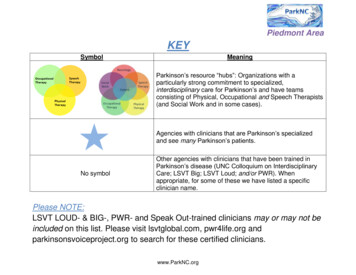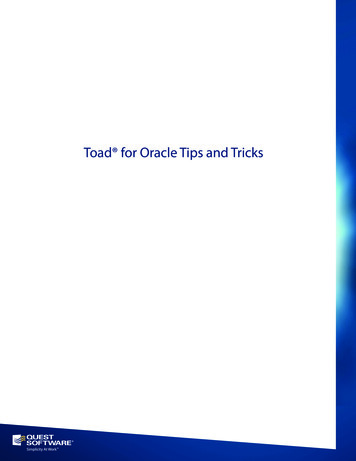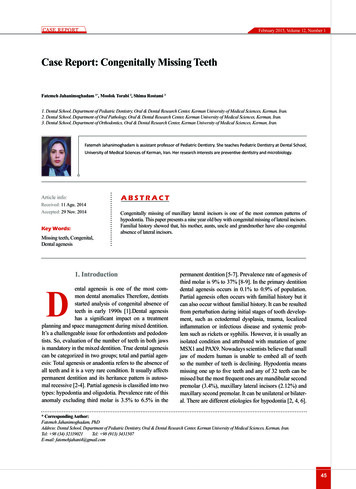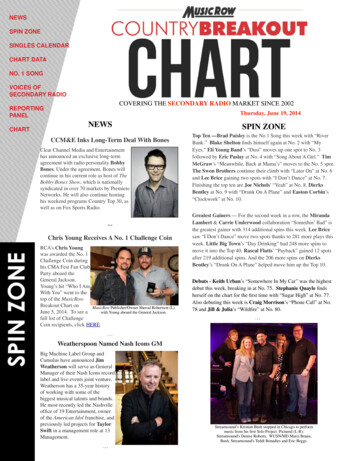
Transcription
A SERIES OF BOOKS IN AGRICULTURAL SCIENCEAnimal ScienceEDITORSG. W. SalisburyE. W. Crampton (1957-1970)
WILDLIFE ECOLOGYAN ANALYTICAL APPROACHAARON N. MOENCornell Universitywith a foreword by Douglas L. GilbertColorado State UniversityW. H. FREEMAN AND COMPANYSAN FRANCISCOrn
Copyright 1973by W. H. Freeman and CompanyNo part of this book may be reproduced by any mechanical,photographic, or electronic process, or in the form ofa phonographic recording, nor may it be sto red in a retrievalsystem, transmitted, or otherwise copied for public orprivate use without written permission of the publisher.Printed in the United States of America12345 6 789Library of Congress Cataloging in Publication DataMoen, Aaron NWildlife eco logy.1936-Bibliography: p.1. Zoology - Ecology. 2. Wildlife management.3. Ruminantia. I. Title.QH541.M54599'.735'04573-6833ISB N 0-7167-0826-4
RT 1LIFE, INTERACTIONS, AND ECOLOGICALMODELING1PRODUCTIVITY GRADIENTS1-1 The concept of life1-2 The role of the analyti ca l ecologist1-3 Dead or alive1-4 Productivity of the individual1-5 The natural mosaic1-6 Interspecies interaction1-7 Intraspecies interaction1-8 Reproductive patterns1-9 A theoretical mosaic2 INTERACTIONS BETWEEN ORGANISMS ANDENVIRONMENT2-1 Functional re la tionships2-2 The scope of the environment33455710111213161621OPERATIONAL, POrENTIAL, AND HISTORICAL RELATIONSHIPS21TIME24ASSOCIATED RELATIONSHIPS25HABITAT EVALUATION263 ECOLOGICAL MODELING AND SIMULATION3-1 Mathematical models3-2 The analyti cal mode l in ecology323336
viCONTEN TSPART 2THE DISTRIBUTION OF MATTER AND ENERGYIN TIME AND SPACE45SOIL, WATER, AND TOPOGRAPHY434-1 Soil44PHYSICAL CHARACTERISTICS44SOIL PROFILE46SOIL WATER46CHEMICAL CHARACTERISTICS47BIOLOGICAL CHARACTERISTICS484-2 Soil classification in transition4-3 Eutrophication4-4 Biogeochemical cycles5153WEATHER IN RELATION TOPHYSICAL CHARACTERISTICS575-1 The distribution of sunlightTHE AT MO SPHERE5-2 Atmospheric water5-3 PrecipitationRAIN5760626262RAINFALL IN RELATION TO SOIL AND TOPOGRAPHY66SNO W68696969CONDUCTIVITY5-4 Snow cover in relation to kinetic energyWINDPACKTHE EFFECT OF WINDBREAKS70SNOWFALL INTERCEPTION727272THE ROLE OF SNOW IN A PRECIPITATION-CANOPY-SUBSTRATE MODELTHE EFFECT OF SNOW DISTRIBUTION ON ANIMALS652WEATHER AND THE PROCESSES OFTHERMAL EXCHANGE6-1 The four modes of heat transfer6-2 Radiant energy exchange75THE ELECTROMAGNETIC SPECTRUM757676SOLAR RADIATION77INFRARED RADIATIONATMOSPHERIC EMISSION787880RADIATION FROM PHYSICAL AND BIOLOGICAL OBJECTS84ATMOSPHERIC TRANSMISSION AND ABSORPTION CHARACTERISTICSEMISSIVITY AND REFLECTIVITY OF SNOW85RADIANT TEMPERATURE IN RELATION TO AIR TEMPERATURE85
CON T EN TS6-3 Instrumenta ti on for measuring rad iation6-4 Convecti onA IR MOVEMEN TMEAN VELO CITY W I ND PROFILES6-56-66-76-8Co nve ctive hea t lossCond uctionHeat loss by eva porati onConcl usio n90929293949798103PART 3METABOLISM AND NUTRITION7ENERGY METABOLISM1097-1 Basal me tabo lism and associated terminology110110110112112112112USES FOR MEASUREMENTS OF BASAL METABOLIC RATECONDITIONS FOR MEASUREMENTASSOCIATED TERMINOLO GY7-2 Measurements of basal metabolic rateDIRECT METHODSINDIRECT METHODSCALCULATIO N OF HEAT PRODUCTION7-6 Social and psychological effects on heat 29129130130130DIGESTION1358-1 The definition of digestion8-2 A research philosoph y8-3 Chemical composition of food ma terials1351351361371371387-3 Metabolic rates of ruminantsRELATIONSHIPS OF BODY WEIGHTMETA BOLIC RATES OF WILD RUMINANTSFASTING METABOLISM OF DOMESTIC RUMINANTS7-4 Metabolic rates of other animals7-5 Factors influencing energy me ta bolism and heat productionTHE RELATIONSHIP BETWEEN HEAT PROOUCTI ON AND SURFACE AREAHEAT INCREMENTS DUE TO DIETHEAT INCREMENTS DUE TO ACTIVITYNONSHIVERING THERMOGEN ESISSEX DIFFERENCESREPRODUCTIVE CONDITIONRHYTHMIC CH ANGES I N THE BASA L METABO LI C RATEI NSULATION CHARACTERISTICSWEATHERPATHOGENS AND PARASITES8WATERNITROGENOUS SUBSTANCES-CRUDE PROTE I NCARBOHYDRATES-NITROGEN - FREE EXTRACTvii
viiiCONTENTSCARBOHYDRATES-CRUDE FIBERETHER EXTRACTASH138SUMMARY OF PROXIMATE ANALYSIS1398-4 The nutritive evaluation of forages8-5 The alimentary canalANATOMYHISTOLOGY8-6 Mechanical and secretory processes in digestionINGESTIONSALIVATION AND MASTICATIONR UMINATIONSTOMACH AND INTESTINAL MOVEMENTSDEFECATION8-7 Chemical processes of digestion139141141144145147147147147149149RUMEN 157157159159pH8-8 Products of fermentationHEAT ENERGYGASESVOLATILE FATTY ACIDSPROTEINVITAMINS AND MINERALS8-9 Passage of digesta through the gastrointestinal tract8-10 Digestion and absorption in the gastrointestinal tract8-11 Summary9138138INGESTION AND NUTRIENT UTILIZATION1649-1 Variations in nutrient intake164164165166166167167171172175SEASONAL VARIATIONSINDIVIDUAL VARIATIONS9-2 Regulation of nutrient intakeRELATIONSHIP TO WEIGHTRELATIONSHIP TO ENERGY EXPENDITURECONTROL OF INTAKE9-3 Energy utilizationPATHWAYS OF ENERGY UTILIZATIONNET ENERGY FOR MAINTENANCENET ENERGY FOR PRODUCTION176SUMMARY OF ENERGY UTILIZATION1761761771771771781791829-4 Protein utilization9-5 Efficiency of nutrient utiliza tionDIGESTION COEFFICIENTSNET ENERGY AND PROTEIN COEFFICIENTSMETABOLIC EFFICIENCY9-6 Body growth9-7 Summary
rCONTENTSPART 4BEHAVIORAL FACTORS IN RELATION TOPRODUCTIVITY1011THE ORGANISM AS A FUNDAMENTAL UNITIN A POPULATION18910-1 Energy, matter, and time19010-2 Biological chronology191INTRASPECIES 4216216Sensory perceptionProtective behavior and family tiesMovement patternsFeeding behaviorRestPlaySocial order217217DOMINANCE PATTERNS11-8 Radio telemetry and behavioral analyses12 INTERSPECIES INTERACTION12-1 Predator-prey relationships12-2 Factors affecting predation rates12-3 Energetic considerationsTROPHIC LEVELS12-412-512-612-7217Man as a predatorParasites and 5236238238PART 5ENERGY FLUX AND THE ECOLOGICALORGANIZATION OF MATTER13 THERMAL ENERGY EXCHANGE BETWEENORGANISM AND ENVIRONMENT13-1 Thermal energy exchange13-2 The concept of homeothermyREGIONS OF THERMAL EXCHANGEANALYSES OF HOMEOTHERMIC RELATIONSHIPS13-3 Measurement of thermal parametersCONDUCTION COEFFICIENTSTEMPERATURE-PROFILE MEASUREMENTS245245246247249250250253ix
CONTENTSTEMPERATURE PROFILES IN FREE CONVECTION14254TEMPERATURE' PROFILES UNDER RADIANT ENERGY LOADS25513-4 Radiant surface temperature related to air temperature25813-5 The concept of thermal depth26113-6 Geometry and surface area26213-7 The calculation of heat loss265PHYSIOLOGICAL, BEHAVIORAL, AND GENETICRESPONSES TO THE THERMAL ENVIRONMENT27314-1 The role of the animal in thermal energy exchange27314-2 The thermal regime and the critical thermal environment27414-3 Heat loss in relation to heat production27514-4 Physiological responses to the thermal environment276THERMOGENIC RESPONSES277THERMOREGULATORY RESPONSES28114-5 Behavioral responses15254TEMPERATURE PROFILES IN FORCED CONVECTION286I ND IVIDUAL RESPONSES286GROUP RESPONSES29214-6 Genetic responses29314-7 Summary296THE ORGANIZATION OF ENERGY AND MATTERIN PLANT AND ANIMAL COMMUNITIES29915-1 Taxonomic relationships30030030630815-2 Morphological relationships15-3 Chemical relationships15-4 Temporal relationshipsSUCCESSION31415-5 A plant-production model316A GEOMETRIC MODEL31 .6A SEASONAL MODEL318A PHYSIOLOGICAL MODEL FOR PREDICTING NET PHOTOSYNTHESIS32115-6 Perturbations325OVERGRAZING325FIRE325PART 6PRODUCTIVITY, POPULATIONS, ANDDECISION-MAKING16A BIOLOGICAL BASIS FOR THE CALCULATIONOF CARRYING CAPACITY33316-1 The conceptual design33316-2 Protein requirements of the individual animal334PROTEIN REQUIREMENTS FOR MAINTENANCE334PROTEIN REQUIREMENTS FOR PRODUCTION336
CONTENTSPROTEIN REQUIREMENTS FOR GESTATIONMILK PRODUCTIONSUMMARY OF THE PROTEIN REQUIREMENTS OF THE INDIVIDUAL16-3 Energy re qui rements of the individual animalENERGY REQUIREMENTS FOR MAINTENANCE AND ACTIVITYENERGY REQUIREMENTS FOR PRODUCTIONENERGY REQUIREMENTS FOR GESTATIONMILK PRODUCTIONSUMMARY OF THE EN ERGY REQUIREMENTS OF THE INDIVIDUAL17MATHEMATICAL ANALYSES OF FACTORSAFFECTING CARRYING CAPACITY17-1 The carrying-capacity model17-2 The program formatINPUTS FOR ANIMAL REQUIREMENTSINPUTS DESCRIBING THE RANGE SUPPLYDECISIONS17-3 Constraints in the animal-range relationship17-4 Program outputs17-5 The dynamic characteristics of the animal-rangerelationships17-6 Weight changesABSOLUTE VALUESPERCENTAGE OF BODY WEIGHTLACTATION EFFECTS17-7 Forage ingestedRELATIONSHIP TO BODY WEIGHTMA INTENANCE-GAIN COMPARISONSFORAGE CONSUMPTION DURING GESTATIONFORAGE I NGESTED AS A FRACTION OF THE PHYSICAL RUMEN CAPACITY17-8 Physiological efficiencyME TABOLIC FECAL NITROGEN AND NET PROTEIN RELATIONSHIPS33634134434734735235235435636536536 80META BOLIC FECAL NITROGEN, FORAGE INGESTED, AND NETPROTEIN COEFFICIENT RELATIONSHIPS380METABO LIC FECAL NITROGEN, BODY WEIGHT, AND NET PROTEINCOE FFICIENT RELATIONSHIPS38]BODY WEIGHT, NET PROTEIN COEFFICIENT, AND PHYSICAL RUMENCAPAC ITY RELATIONSHIPS17-9 The expression of carrying capacity in deer-daysEFFECTS OF BODY SIZEEFFECTS OF SNOW DEPTHFORAGE PRODUCTION AT DIFFERENT STAGES IN SUCCESSIONI7-1O Summary18382383384386388388N-DIMENSIONAL POPULATION STRUCTURES39018-] Sex and age ratios18-2 Parasitism18-3 Geometry and posture39739839]xi
xiiCONTENTS18-4 Population requirements for protein18-5 Population requirements for energy1918-6 Other population dimensions400400400PREDICTING POPULATION DYNAMICS40419-1 Ecological productivity gradient19-2 The relative importance of different variables404405405406406408408409410410ANIMAL REQUIREMENTSRANGE SUPPLYFACTORS AFFECTING BOTH ANIMAL REQUIREMENTS AND RANGE SUPPLY19-3 Factors to consider in population analyses19-4 Population analyses for n1, 2, . n MORPHOLOGICAL AND PHYSIOLOGICAL CONSIDERATIONSBEHAVIORAL CONSIDERATIONSA THEORETICAL AVERAGE DEER19-5 Time in relation to biological events411THE IMPORTANCE OF SEASONAL CHANGES412413VARIATIONS IN THE TIME OF BREEDING20411SEASONAL CHANGES IN ANIMALS AND PLANTSECOLOGICAL ANALYSES AND DECISION-MAKINGPROCEDURES20-1 The simulation of management practicesBIOLOGICAL CONSIDERATIONSSOCIAL AND ECONOMIC CONSIDERATIONSPOLITICAL CONSIDERATIONS20-2 s and MeasurementsWeather, Thermal Factors, and the Julian CalendarWeight and Metabolic WeightRadiant Temperature in Relation to Air TemperatureSurface Area in Relation to WeightSymbolsReference Books440A-8Instructions for Contributors to the Professional 8445
FOREWORDInrecent years, environmental problems have created great general concern. Thus,the time has come when a revitalized and more effective approach to the management of natural resources is necessary. This is especially true in light of increasedhuman populations.In the past, individual abuses of the natural resources have been treated asisolated problems-an approach doomed to failure . Instead, individual abuses canbe seen as parts of a larger problem: the increasing pressure of an expandingpopulation on dwindling nature resources. That problem often appears overwhelming. Ia seeing it, many have given up in despair. But a great problem maybe broken down; each part can be attacked separately and perhaps solved. Bitby bit the big problem becomes solvable. The importance of each issue, whetherit be protein availablility, harvest of females, or disposal of waste pollutants,depends on the particular role of the issue in the overall environmental structure.Wild animals, and the management of them are a vital part of the environmental "machine," a part that also is made of smaller parts. Age, sex, and timeof year affect the physiology of an individual animal. These, together with nutritional factors, genetic history, and features of the physical environment, combinein the complex system that determines the interactions between an animal, otherorganisms, and the land.It is the essence of the wildlife manager's job that he understand the systemand be able to work with it. H must understand how an organism fits into theecosystem. He must understand the effects of the organism on its total environment and the effects of the environment on the organism.In Wildlife Ecology: an analytical approach, Professor Moen has analyzed thisnatural system. He evaluates each component and welds them together into aunified whole . Although most of the examples deal with white-tailed deer, theconcepts are applicable to the other wild ruminants and, indeed, to all organisms.xiii
xivFOREWORDProfessor Moen's creative research and dedication have produced a work inwhich traditional pieces of wildlife management- numbers and conditions ofanimals, nutritive values of range plants, behavior patterns-are at last presentedas parts of a greater whole . This book should be made available to every wildlifeprofessional, wheth.er technician, manager, biologist, conservation officer, administrator or researcher. It is an important publication and the time for it has come.Douglas L. GilbertColorado State UniversityFort Coll ins, Colorad oSeptember 1972
PREFACERapid advances in analytical capabilities within the last fifteen years have madeit possible for the ecologist to do things within a time dimension that were unheardof a few yea rs ago . The capabilities for rapid analyses pose a threat to thediscipline of ecology, however, because there can be a tendency to use numbers,large quantities of them, hoping by some magical means of computer analysisto find some relationships emerge.The reorganization of numbe s within a computer program of storage andcompu tation is nothing more than a rapid bookkeeping system. Computers usedin such a way do n ot usually help much in gaining insight into the mechanismsthat are operating in the natural world. They tend to promote a false sense ofsecurity.The real benefits of computer analyses emerge if they are used to extend theanalyst' s capabilities for analyzing the relationship between one factor or forceand another factor or force in the ecosystem. It is important to realize that thehuman min d must always be ahead of the computer, with the electronic systemdoing rapid computations that are too numerous and time-consuming to do inany other manner. This suggests that the first models built by analytical ecologistsare of necessity very simple ones . Let them be no more complex than the modelbuilder can full y comprehend, insuring that he knows not only the capabilitiesof his analytical model but also its weakness. A progression of such simple modelswill result in more complex, working models that represent a known portion ofthe ecosystem.In this book I have aimed at promoting the building of simple but workablemodels . They do not require large computer centers for their use; small desk-topcomputing systems are entirely adequate. In fact, many of the models suggestedcan be done manually, with the principles of model building illustrated just asxv
xviPREFACEwell. Thus the book should be of interest to ecology classes in many types ofeducational institutions, from the small college to the major university. I amconvinced that, wherever the student is located, the major factor that will determine his progress in ecology is his ability to think, along with the guidance ofa professor who stimulates thinking about meaningful ecological relationships.Aaron N . MoenApril 1973
ACKNOWLEDGMENTSof1merofps.oenThecompletion of a book is not possible without the help of many people. Myown -efforts have been made possible through the kind direction and guidancegiven to me by my parents on their farm in western Minnesota. The opportunitiesfor contact with wild animals and native plants in that area stirred within mean interest to pursue an understanding of the relationships between organismand environment.My academic career in the field of natural resources began under the guidanceof Dr. Max Partch at St. Cloud State College. His enthusiasm for teaching in thefield impressed me greatly. Dr. William H. Marshall, of the University of Minnesota, gave me opportunities, freedom, and responsibility as I pursued a PhD.The most significant academic work that permitted me to delve into the energyrelationships of deer at that time was that of Helenette Silver and her colleaguesat the New Hampshire Fish and Game Department and the University of NewHampshire. Without her pioneering efforts in the field of energy metabolism ofwhite-tailed deer, my PhD. dissertation could not have started me on the challenging research on the energetics of a free-ranging animal.I wish to thank the many friends I have made in the field of wildlife management, especially the deer biologists in the State of New York who always providestimulating interaction as we proceed together to understand this most importantresource in New York State. My colleagues at Cornell, especially Dr. Peter VanSoest of the Department of Animal Science, have provided many insights intothe animal-environment relationships currently under investigation. Dr. DouglasL. Gilbert, formerly at Cornell and now at Colorado State University, has discussedbig-game management with me on many occasions. Dr. Donald Ordway and hisstaff of aerodynamic engineers have been of great help in our thermal analysesat the BioThermal Laboratory.xvii
xviiiACKNOWLEDGMENTS.,Dr. Dwight A. Webster, former head of the Department of Naturai Resources,and the administrators of the Agricultural Experiment Station at Cornell haveall been most helpful as I established a research program at the BioThermalLaboratory. Funds for research at the Laboratory have been contributed throughthe Pittman-Robertson Federal Aid program, Project W-124-R, and the New YorkState Department of Environmental Conservation. Additional funds from theAgricultural Experiment Station at Cornell, the Cornell Research Grants Committee, the National Science Foundation, The Loyalhanna Foundation, and the National Rifle Association have helped support the work at the BioThermal Laboratory.The staff at the Laboratory has contributed significantly to the work that isdescribed in this text. My respect for the abilities and dedication of my studentscannot be fully expressed by acknowledgment but will be manifested by theircontributions in the future. I must recognize the help and accomplishments offormer students, especiq.lly Dr. Keith. E. Evans and Dr. Deborah S. Stevens. Thework of Nadine L. Jacobsen and Charles T. Robbins, both PhD. candidatesstudying the energy relationships of deer, has provided much insight into thecomplex animal-environment relationships that are the focus of study at theLaboratory. William Armstrong, laboratory technician, has helped in the designand construction of research equipment and in the care of our experimental deerherd. Richard E. Reynolds, foreman at the Ithaca Game Farm, has contributedmuch to the program with his help in the construction of the deer pens, maintenance of the facilities, and continual attention to our needs . Eleanor Horwitzoffered many fine suggestions on ways to improve the manuscript. I appreciateher efforts to convince me to say things in the simplest way possible.Students in my courses have raised many stimulating questions. I wish thateach one of them could participate actively rather than passively in the educationalprocess of research and discovery.Finally, the help and encouragement of my wife, Sharon, and of Ronald,Thomas, Daniel, and Lindy cannot be fully expressed in words . It has often beenimpossible to keep up with some of the domestic duties confronting every husband and father because of the urgency of research according to a biological clockand my own intense interest in the subject. As Tom (age 9) said when I suggestedI might write another book, "Oh no, not another five years of that!"
:es,avenal19harkthenit\Ja)rat is nts1eir; 'eenlUS-ock;tedWILDLIFE ECOLOGY
Courtesy of Paul M. KelseyNew York State Department of Environmental Conservation . . . .t .-.--- --. - --- ---
a series of books in agricultural science animal science editors g. w. salisbury e. w. crampton (1957-1970) wildlife ecology an analytical approach aaron n. moen . carbohydrates-nitrogen-free extract 138 . viii contents carbohydrates- crude fiber ether extract ash summary of proximate analysis










